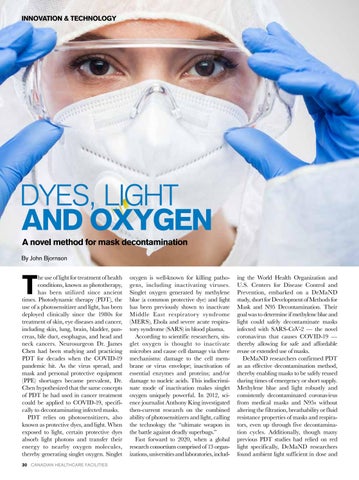INNOVATION & TECHNOLOGY
DYES, LIGHT AND OXYGEN A novel method for mask decontamination
By John Bjornson
T
he use of light for treatment of health conditions, known as phototherapy, has been utilized since ancient times. Photodynamic therapy (PDT), the use of a photosensitizer and light, has been deployed clinically since the 1980s for treatment of skin, eye diseases and cancer, including skin, lung, brain, bladder, pancreas, bile duct, esophagus, and head and neck cancers. Neurosurgeon Dr. James Chen had been studying and practicing PDT for decades when the COVID-19 pandemic hit. As the virus spread, and mask and personal protective equipment (PPE) shortages became prevalent, Dr. Chen hypothesized that the same concepts of PDT he had used in cancer treatment could be applied to COVID-19, specifically to decontaminating infected masks. PDT relies on photosensitizers, also known as protective dyes, and light. When exposed to light, certain protective dyes absorb light photons and transfer their energy to nearby oxygen molecules, thereby generating singlet oxygen. Singlet 30 CANADIAN HEALTHCARE FACILITIES
oxygen is well-known for killing pathogens, including inactivating viruses. Singlet oxygen generated by methylene blue (a common protective dye) and light has been previously shown to inactivate Middle East respiratory syndrome (MERS), Ebola and severe acute respiratory syndrome (SARS) in blood plasma. According to scientific researchers, singlet oxygen is thought to inactivate microbes and cause cell damage via three mechanisms: damage to the cell membrane or virus envelope; inactivation of essential enzymes and proteins; and/or damage to nucleic acids. This indiscriminate mode of inactivation makes singlet oxygen uniquely powerful. In 2012, science journalist Anthony King investigated then-current research on the combined ability of photosensitizers and light, calling the technology the “ultimate weapon in the battle against deadly superbugs.” Fast forward to 2020, when a global research consortium comprised of 13 organizations, universities and laboratories, includ-
ing the World Health Organization and U.S. Centers for Disease Control and Prevention, embarked on a DeMaND study, short for Development of Methods for Mask and N95 Decontamination. Their goal was to determine if methylene blue and light could safely decontaminate masks infected with SARS-CoV-2 — the novel coronavirus that causes COVID-19 — thereby allowing for safe and affordable reuse or extended use of masks. DeMaND researchers confirmed PDT as an effective decontamination method, thereby enabling masks to be safely reused during times of emergency or short supply. Methylene blue and light robustly and consistently decontaminated coronavirus from medical masks and N95s without altering the filtration, breathability or fluid resistance properties of masks and respirators, even up through five decontamination cycles. Additionally, though many previous PDT studies had relied on red light specifically, DeMaND researchers found ambient light sufficient in dose and
